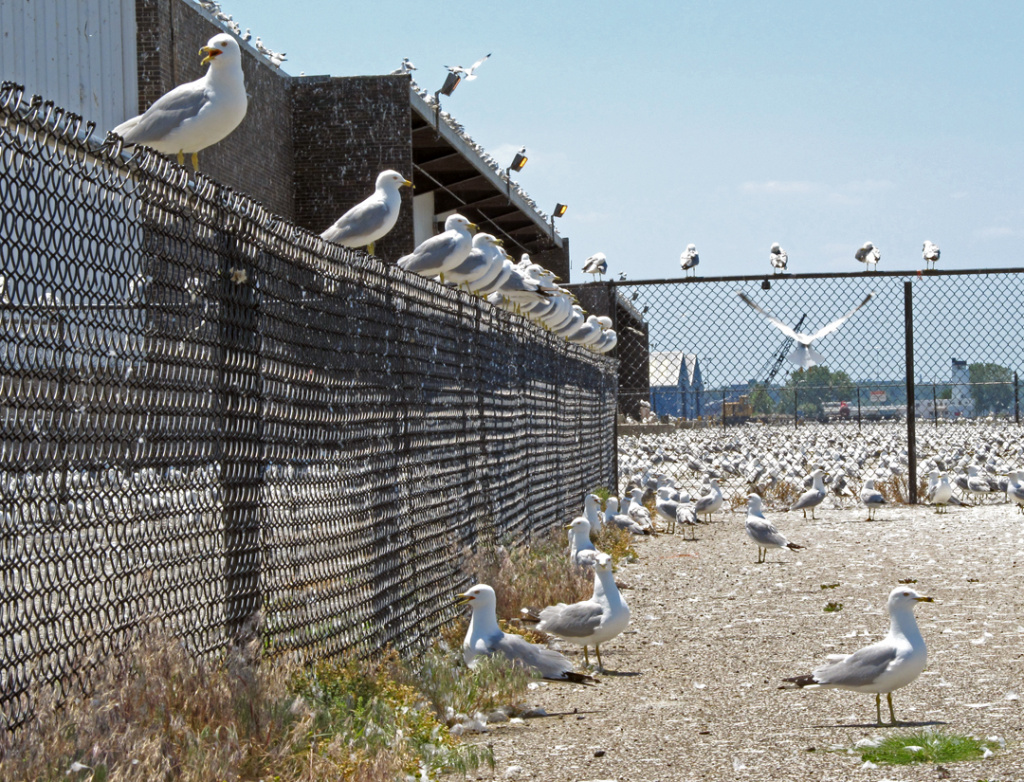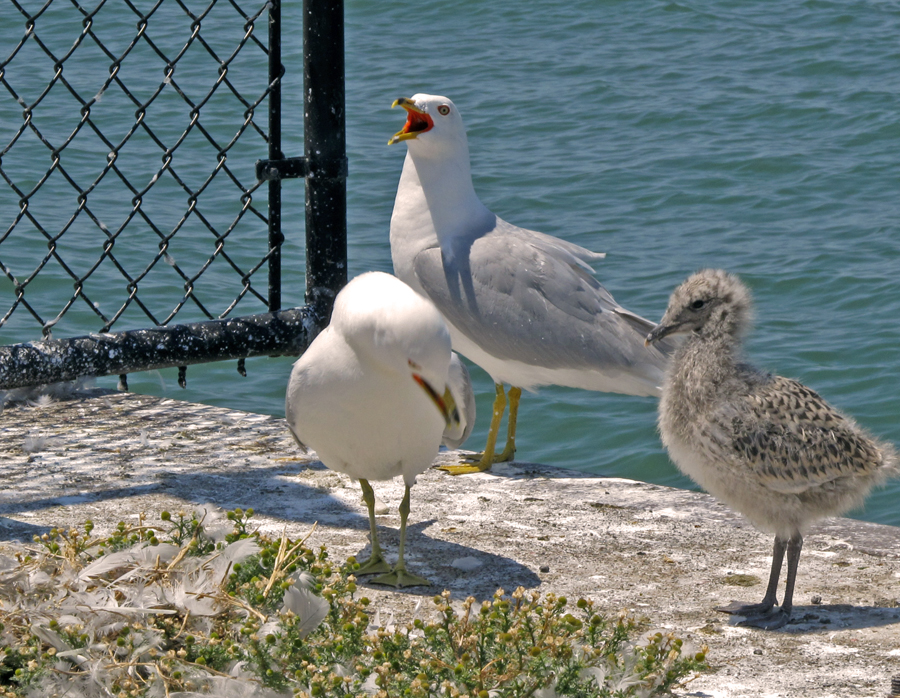
Photo: Carol Terracina Hartman.
On the shores of Lake Erie near Cleveland, Ohio, adjacent to an industrial area housing the Cleveland Browns Stadium, the Rock ‘n Roll Hall of Fame, and the Great Lakes Science Center, is home to a large colony of ring-billed gulls. The gulls build their nests on the ground and line it with grass, reeds and rushes and typically hatch 2-4 eggs at a time. Mom and Dad share the sitting duties.
These photos show the colony, the nest sitters, a nest and the “guards” who line the fence to warn the parents-to-be of impending intruders.

Photo: Carol Terracina Hartman.

Photo: Carol Terracina Hartman.
Who says it’s not a problem? Gull “poo” can foul more than just docks, piers, beaches and harbor walkways. The accumulation of it can destroy certain roofing materials, boat and pool covers, even streetlights. The bacteria and ectoparasites in the droppings can host diseases. Gull droppings in ag areas can foul forage meant for livestock, and gulls are a primary contributor to bird-aircraft strikes. Even if you thinned half the gulls you’d have more than enough to photograph and enjoy. You might also have fewer beach closings and a 50 percent reduction in “poo” on the piers, boardwalks, marinas and boats, too. I’m an avid birder and photographer, but I probably spend 50-100x more on boating and fishing than I do birding and taking pictures.
Scoop:
Seems like an awful lot of effort for something that’s not even a problem yet. Given the state of the environment in the Great Lakes and what’s coming from the threats of fracking and Asian carp, ring-billed gulls are just something to photograph and enjoy right now. We have much more to worry about than some boater whining about poo on his boat.
Dean, I know “we” are sometimes the problem, many times, in fact. I’ve even got some “hugger” friends who suggest we need downsizing. Wouldn’t you know that every time I look them in the eye and ask if they’d like to be the first to go – or any of their loved ones, for that matter – it’s a different story. Geese don’t need lawns. They use ’em because they’ve saturated other habitat, and know they’re “safe” in urban areas (some communities have had enough and are culling them and donating to food pantries). Deer love woodlands, esp. young forests, and can thrive in a prairie/forest mix. Maybe we need more wolves? Sounds great to those who live in urban areas. You should see their faces when you tell them how coyotes and wolves have attacked and killed humans in recent years (yes I know it’s very rare, but it happened), and you ask them if they’d like wolves introduced into their grandchildren’s backyards. Again, different story. Am I saying shoot all the gulls and cormorants? Heck no, maybe just more aggressive egg oiling and some adult culling, yes, to thin them back some. If you were an avid boater/angler and you woke up to bird “poo” all over your boat or couldn’t even walk on a breakwall to fish without stepping in it, you might better understand the severity of the overpopulation problem. Hazing them at nesting sites just sends ’em to be a problem in the next port.
Hey Dean, why? Because that’s what makes the world go ’round. Without economic drivers like sport fishing, for example, many small town (and plenty of “big town”) economies would flounder. Boating, fishing and hunting are among the outdoor pursuits that have weathered the recession better than most, and for good reason. Healthy recreation, organic eats and excise taxes on fuel and equipment that fund land buys, programs and projects for all to enjoy, even the non-boat, non-fish, no-hunt crowd.
Hi Scoop,
Why assume things need to be managed from a anthropocentric point of view? Manage geese by outlawing the lush lawns they feed on. Manage deer by returning to native prarie and woodlands. Manage cormorants by allowing them to breed until there are not as many trees on the islands for them to nest in (their droppings will handle it).
Why not manage the swimmers? How about other sources of nutrients for bacterial growth? Yes, I’m saying if we manage the humans a lot of these problems can be reduced or eliminated. Remove human waste from the water, eliminate run-off from the lawns and agricultural lands and the problems will be reduced. Humans brought the gobies cormorants love so much. We are the problem. “Downsizing” only works with constant input, if we reduce our contributions to the problems we can solve them.
Reduce the gulls and we can also smell the garbage they eat as it rots until another scavenger builds up in population to take care of it. We feed the geese, and gulls and provided nesting for the cormorants when DDT was limiting their nesting success. They’ll limit their own population if we return control to the processes they evolved in.
Be Well,
The DeanofDance
Nice series
Has there ever been a thought that some of these bird colonies should be “downsized” to put it kindly? The mess they make on public and private piers, beaches and boats is a real nuisance for recreational users, and no doubt contributes big-time to water quality issues for swimmers. We “manage” Canada geese, deer, wild turkeys and so many other critters – and finally have been trying to manage double-crested cormorants. Why not gulls?